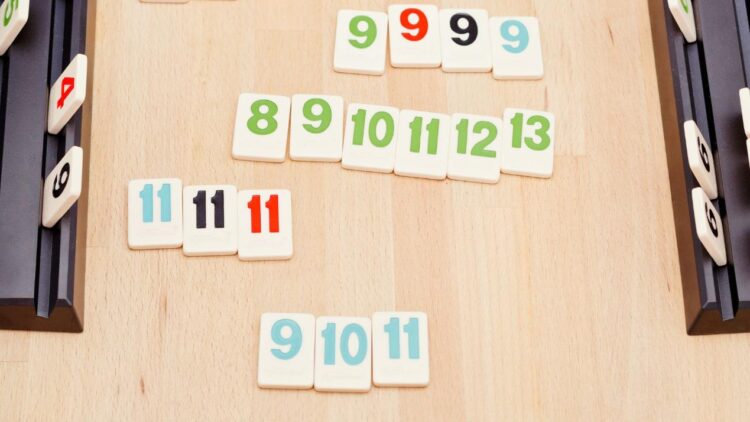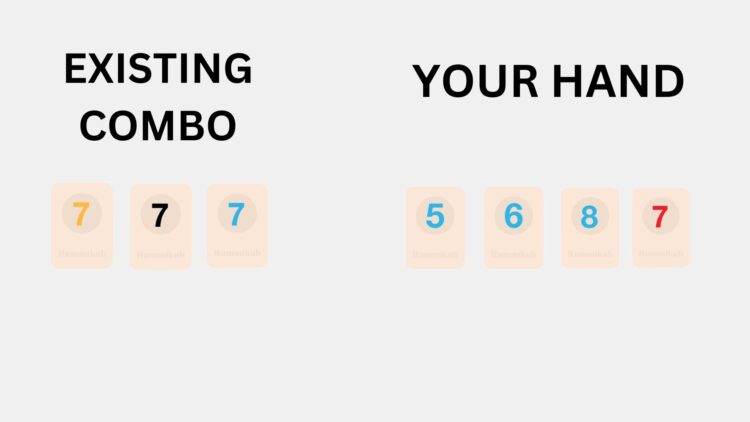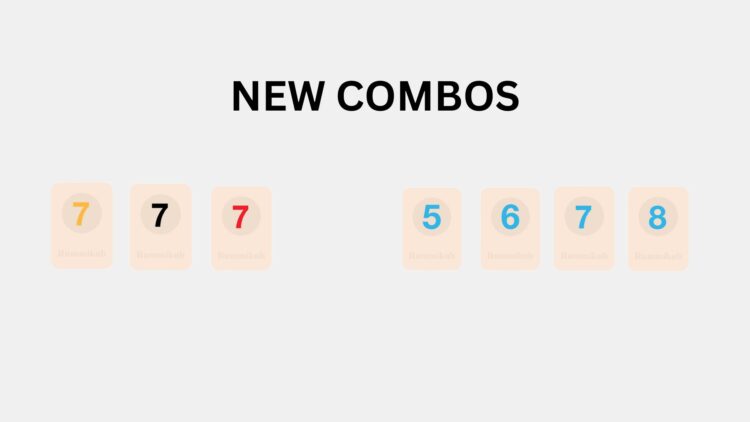
OBJECTIVE OF RUMMIKUB: Get rid of all the tiles on your rack by organizing them into runs and groups OR have as few points in your hand as possible.
NUMBER OF PLAYERS: 2 to 4 players
MATERIALS: 106 tiles with numbers and colors, including two jokers, 4 tile racks
TYPE OF GAME: Board game
AUDIENCE: All ages
OVERVIEW OF RUMMIKUB
This post contains some partner links for various products.
- With more than 55 million units sold, Rummikub is one of the world's...
- Players take turns placing numbered tiles in runs or groups, Rummy style - the...
- Fast-paced, easy gameplay is ideal for people of different ages to play together
Pronounced rummy cube, Rummikub is a fun and strategic board game that pits two to four players against each other. Players attempt to get rid of tiles by matching them up into groups of the same number or consecutive numbers. This game has been around for almost 100 years and remains an extremely popular board game played by families around the world.
In this article, we will be diving into the rules of Rummikub so that you can learn how to play this simple and entertaining board game that you could play with your family for hours on end!
THE HISTORY OF RUMMIKUB
Rummikub has a fascinating history that’s worth getting to know. This game was introduced to the Western world by its inventor, Ephraim Hertzano. Tile rummy was introduced in response to religious and legal sanctions on card games like rummy due to their association with gambling. It is believed to have been conceived in the 1930s or 1940s in Romania and has since gained international success, becoming one of the 10 best-selling games in the world. Sabra Rummikub is the only variation of Rummikub included in recent versions of the game and is the version described below.
If you want to play a similar game with a deck of cards, check out these rummy card games.
So, without further ado, let’s go over the rules and how to play the beloved board game of Rummikub.
SETUP FOR RUMMIKUB

Here’s how to set up a game of Rummikub before you get this fun game started!
WHAT’S IN THE BOX?
Rummikub includes 106 tiles, including two jokers. The tiles are either black, red, yellow, or blue and contain the numbers 1 through 13.
DEALING
To start, shuffle all the tiles face down. Then, each player picks one tile, and the player with the higher number goes first. Play then passes clockwise or anti-clockwise, depending on how you want to play.
All players must return their tile. Then, each player takes 14 random tiles. Players place their tiles on their rack in a way that they are hidden from other players. All remaining tiles must remain face down on the table to form a pool. It’s best to keep several stacks of this pool to draw from next to players rather than in the middle of the table.
HOW TO PLAY RUMMIKUB

The goal of Rummikub is to form groups or runs of different tile combinations in order to get rid of all your tiles or as many tiles as possible (in order to have the lowest value hand). When you form a group or run in Rummikub, you can place the tiles face up on the table.
Okay, but before we really dive into the rules, it’s first important to understand what groups and runs are. These are potential combinations of tiles:
- Group: 3 or 4 tiles of the same number but different colors.
- Run: 3 or more numbers in a sequence of the same color.
Note that you can only count tiles in a single combination and cannot be used in multiple groups or runs.
STARTING THE GAME
Choose a player to start the game. This player must either form a combination or draw a tile.
The first combination a player plays has a specific rule to keep in mind. From their 14 tiles, a player must play a combination (at least 3 tiles to form a group or run) that equals a total value of 30 or more points. If a player uses a joker in the initial set, its point value is the tile it represents. This is how a player “buys in” to the game. For example, in order to start playing, a player may lay down four blue tiles numbered 8, 9, 10, and 11.
If a player is unable to buy into the game, they must draw a tile to end their turn.
After a player either buys in or draws a tile, the next player does the same.
After a player lays down their first combination, on future turns, they can then play any tile or tiles that they can add to any existing groups or runs. Confused? Don’t worry! We’ll get into this now.
When playing tiles, players can either create a new combination, add on to an existing combination, or rearrange the tiles to form a new combination. If a player is unable to play anything, they must draw a tile.
CREATING A NEW COMBINATION
After you buy into the game, you can now play whatever tiles you want in your rack without having to worry about anything adding up to 30. In other words, you can start slowly getting rid of all your tiles! One way to do this is to create a new combination. You can put down any combination, even if it doesn’t add to 30. Place any new combinations down on the table face-up for the other players to see.
Examples of combinations include a group that consists of a blue 4, a red 4, and a yellow 4. Or a run that consists of a yellow 2, yellow 3, and yellow 4.
ADDING TO AN EXISTING COMBINATION
You are not restricted to playing on only your own tiles. Any player can add tiles to an existing combination on the table.
For example, if a player has played the combination red 7, red 8, and red 9 and you have the tiles red 6 and red 10, you can add these to the combination to make 6, 7, 8, 9, 10.
In the same way, if there is an existing combination of 8, 8, 8 (note: they must be all different colors) and you have another 8-tile in a different color, you can add it to the existing combination.
REARRANGING AN EXISTING COMBINATION
You can also rearrange existing combinations by adding your own tiles and creating new combinations. If you rearrange the tiles, you must use all the tiles from the existing combination. You can separate the tiles into a couple of different combinations. Just remember that all combinations must contain at least 3 tiles.
Here is an example of rearranging Rummikub tiles:

Your Hand: You have 5, 6, 8 tiles in blue and a 7 in red.
Existing Combo: On the board, there is an existing combination of three 7s in black, blue, and yellow.
New Combos: On your turn, you can take the blue 7, combine it with your blue, 5, 6, and 8 to create a 4-tile run, and add your red seven to the remaining two 7s in the existing combination.

DRAWING TILES
If you cannot add any tiles to the table using any of the methods above, you must draw a tile from the pool. Your turn is over, and play passes to the next player. You may not play a tile directly after drawing it.
TIME LIMIT
An interesting rule for Rummikub is the time limit. Due to the complexity and numerous amount of possible rearrangements, there is a time limit imposed on turns: 2 minutes.
Any player who goes over the 2-minute limit must take a tile as a penalty.
And if a player reaches the time limit before successfully rearranging the tiles into valid combinations, they must return all the tiles to the configuration it was in when the turn began. Players must also return their played tiles back to their rack and draw three tiles.
So, basically, play everything you can within two minutes!
RUMMIKUB JOKER RULES
There are two joker tiles in Rummikub that essentially function as wild cards. If you draw a joker, you can use it to fill in a blank space of a combination. The joker tile can represent any number or color. For example, if you have 5, 6, and 8 in color, you can use a joker tile to fill in for the 7.
You can also add to existing combinations with jokers, but you cannot move or rearrange the tiles from a joker combination. The only way you can take a joker from a combination is to replace the joker with the tile it is supposed to represent. So, in the example above of a 5, 6, joker, and 8 combination, if you have the 7 of that color, you can then take the joker.
However, the caveat is that you must play the joker immediately. You cannot take it for future use.
Additional Rummikub joker rules include:
- If you have not yet played your first set, you cannot take the joker from the table.
- If you have a joker in your rack at the end of the game, it has a penalty value of 30 points. So, use it when you have it!
SCORING

The scoring rules for Rummikub can get a bit confusing, so pay attention!
The first player to play all their tiles on their rack yells, “Rummikub,” and ends the round with a score of 0. All other players must sum the total of their remaining tiles on their rack – as mentioned, jokers count for 30 points! These scores are then totaled as a negative amount.
So, if a player still has a 7 and 4 on their rack, they have a total of -11 points! And if another player still has an 11, 3, and joker on their rack, they have -44 points.
On the other hand, the winner of the round gets a positive score that is equal to the total of every other player’s points.
This means in the example above, the winner has a total of 55 points, while the other two players have -11 and -44 points.
If the pool of tiles runs dry before any players run out of tiles on their rack, play continues until no player can play any more tiles. In this case, the player with the lowest tile total is the winner. Then, each player subtracts the winner’s total from their tile value and turns it into a negative score.
For example, if the winner has a 3 left on their rack at the end of the game, each player must subtract 3 from whatever they have left on their board. So, if one player has an 8 and 2, their score would be a 7 turned into a negative value, which would be -7. The winner’s total score would be the total of all the negative scores turned into a positive number. So, if the losing players scored -7, -3, and -11, the winner’s score would be 21.
After you score the round, mix up all the tiles and put them to the side once again to begin the next round, starting from the top!
END OF GAME
Keep playing a new round of Rummikub until a player reaches a predetermined score that players agree to at the beginning of the game. Each player should calculate their negative and positive points after each round, and the player who reaches the target score first wins!
VARIATIONS
Here are a few variations of rules in Rummikub if you want to spice things up a bit:
- Play can move either clockwise or counter-clockwise.
- If you replace a joker in a group combination, some rules state that you should play both missing colors to the group before you can get the joker.
- Jokers may value 25 points as opposed to 30 when left on the rack during scoring.
FAQ
How Many Total Rummikub Tiles Are There?
There are a total of 106 tiles in Rummikub. This includes 104 numbered tiles, from 1 to 13, and colored blue, black, yellow, or red, as well as 2 jokers.
Can You Play Rummikub with 2 Players?
Yes, definitely! You can play Rummikub with as few as 2 players and as many as 4! The best thing is that this board game is just as fun with 2 people as it is with 3 or 4.
How Many Rummikub Tiles Do You Start with?
According to official Rummikub rules, you start with 14 random tiles, which you should arrange on your rack.
- 23 SUPER FUN 4TH OF JULY GAMES - April 23, 2024
- 30 FUN DATE NIGHT GAMES FOR COUPLES - April 18, 2024
- 200+ INSANE “KISS MARRY KILL” QUESTIONS TO ASK - April 16, 2024
